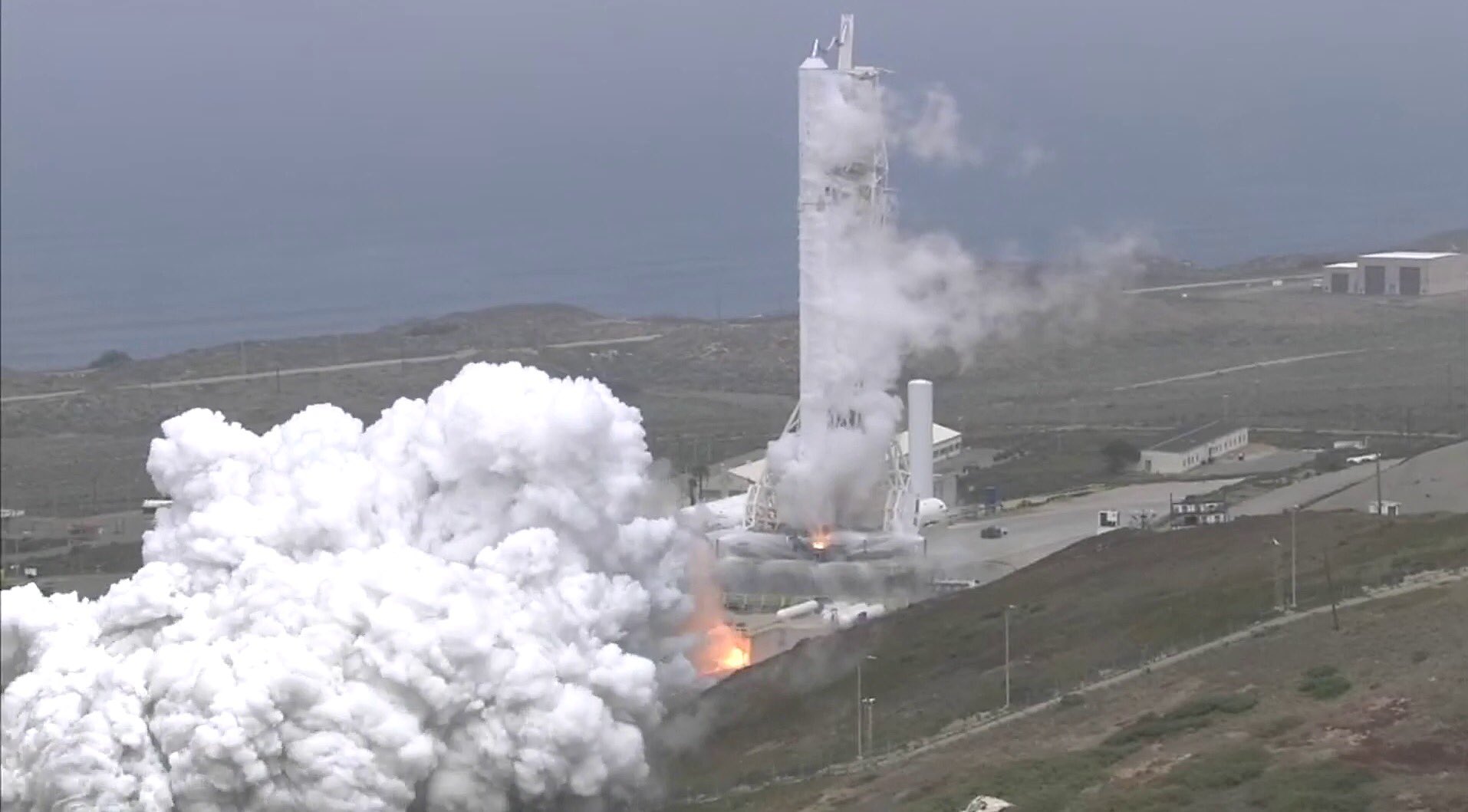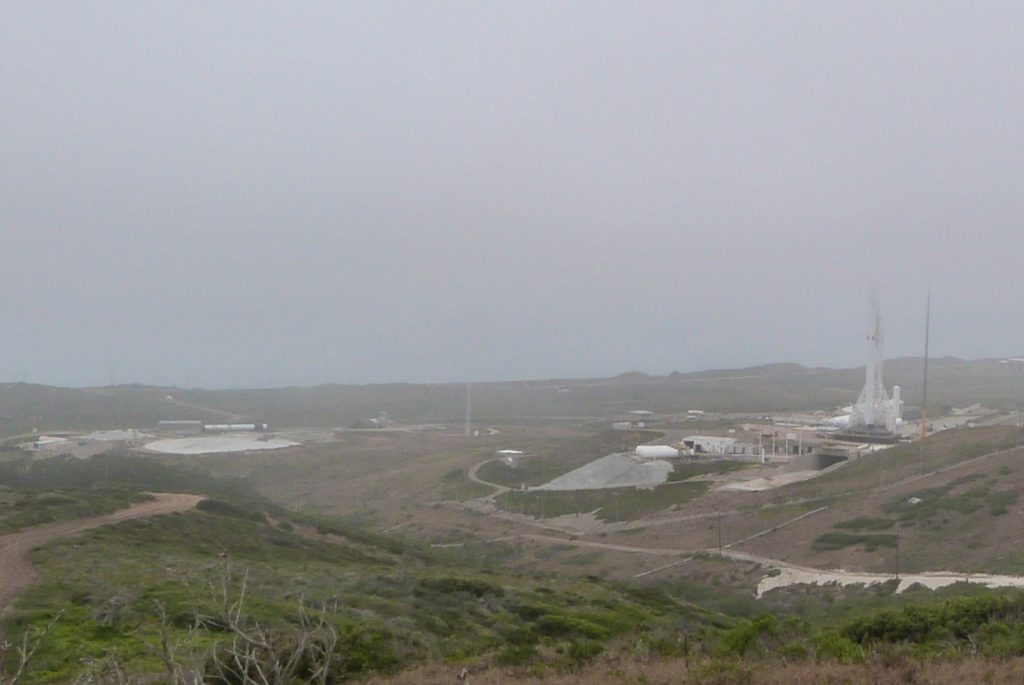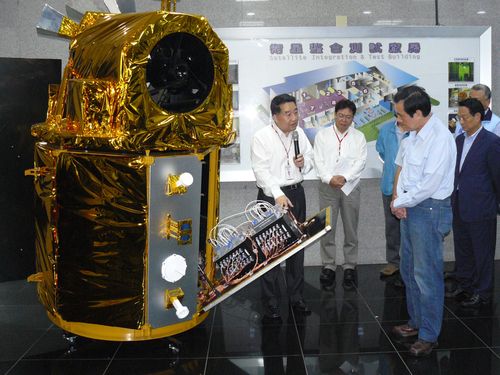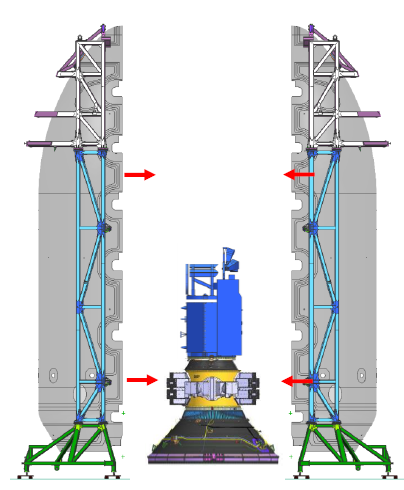

News
SpaceX’s twelfth launch and ninth recovery of 2017 ready for a Thursday liftoff
After conducting a successful static fire on Saturday, August 19, SpaceX is ready to undertake their 12th launch of 2017 and the 40th launch of Falcon 9.
The launch window begins Thursday, August 24, at 11:51 a.m. PST and lasts for approximately 40 minutes, allowing for flexibility in the event of a simple scrub or abort. It will see Falcon 9 carry Formosat-5 into a sun-synchronous orbit approximately 600-1000km above the surface of the Earth, where it will be able to best carry out its duties of remote sensing and Earth observation. Developed by Taiwan’s National Space Organization, the satellite will be the country’s first indigenous remote sensing platform in orbit.
- Formosat-5. (CNC)
- A diagram illustrating Formosat being encapsulated in Falcon 9’s payload fairing. (CNC)
Formosat-5 was originally contracted to launch aboard Falcon 1, SpaceX’s first orbital launch vehicle. Much smaller than Falcon 9, the original choice of launch vehicle made more sense given the satellite’s small mass of approximately 500 kilograms. After many years of delays, SpaceX had instead arranged for the satellite to be launched as a co-passenger alongside Spaceflight Industries’ first SHERPA launch, an orbital tug and dispenser that would have placed approximately 90 satellites of different sizes into unique orbits. However, after SpaceX experienced two catastrophic failures of Falcon 9 within a period of less than a year and a half, Spaceflight chose to rebook all of those passenger satellites on other launches. In spite of the apparent drama, Spaceflight and SpaceX still plan to work together in the future and SpaceX has several SHERPA launches scheduled over the next several years.
Given the size of Formosat-5 compared to Falcon 9, the satellite will be downright minuscule inside the vehicle’s cavernous payload fairing. While it has been reasonably argued that the dedication of an entire Falcon 9 for a 500 kg payload hints at a significant level of inefficiency in the launch industry, the small payload will allow Falcon 9 to attempt an unusually easy recovery on the ASDS Just Read The Instructions. The fifth West-coast mission for SpaceX, the Falcon 9 will lift off from Vandenberg Air Force Base, California before landing in the Pacific Ocean around ten minutes after launch. The choice to land in the ocean has sparked curiosity among fans after photos suggested that SpaceX’s West coast landing zone is complete and all necessary permits and environmental impact reviews have been successfully completed.

SpaceX’s VAFB Landing Zone can be seen in its near-complete state on the left. (NASASpaceflight/Chris Gebhardt)
SpaceX’s only other West-coast missions, seven contracted launches of Iridium’s NEXT constellation, are understood to be too heavy to provide the fuel margins necessary for Falcon 9 to return to the launch site for a landing. As such, the company’s West coast pad may well remain unused well into the future, and SpaceX may simply have chosen to focus their pad engineers on the far more pressing and time sensitive work going on at SpaceX’s East coast launch facilities.
News
Tesla begins Robotaxi certification push in Arizona: report
Tesla seems serious about expanding its Robotaxi service to several states in the coming months.

Tesla has initiated discussions with Arizona transportation regulators to certify its driverless Robotaxi service in the state, as per a recent report from Bloomberg News. The move follows Tesla’s launch of its Robotaxi pilot program in Austin, Texas, as well as CEO Elon Musk’s recent comments about the service’s expansion in the Bay Area.
The Arizona Department of Transportation confirmed to Bloomberg that Tesla has reached out to begin the certification process for autonomous ride-sharing operations in the state. While details remain limited, the outreach suggests that Tesla is serious about expanding its driverless Robotaxi service to several territories in the coming months.
The Arizona development comes as Tesla prepares to expand its service area in Austin this weekend, as per CEO Elon Musk in a post on X. Musk also stated that Tesla is targeting the San Francisco Bay Area as its next major market, with a potential launch “in a month or two,” pending regulatory approvals.
Tesla first launched its autonomous ride-hailing program on June 22 in Austin with a small fleet of Model Y vehicles, accompanied by a Tesla employee in the passenger seat to monitor safety. While still classified as a test, Musk has said the program will expand to about 1,000 vehicles in the coming months. Tesla will later upgrade its Robotaxi fleet with the Cyercab, a two-seater that is designed without a steering wheel.
Sightings of Cybercab castings around the Giga Texas complex suggests that Tesla may be ramping the initial trial production of the self-driving two-seater. Tesla, for its part, has noted in the past that volume production of the Cybercab is expected to start sometime next year.
In California, Tesla has already applied for a transportation charter-party carrier permit from the state’s Public Utilities Commission. The company is reportedly taking a phased approach to operating in California, with the Robotaxi service starting with pre-arranged rides for employees in vehicles with safety drivers.
News
Tesla sets November 6 date for 2025 Annual Shareholder Meeting
The automaker announced the date on Thursday in a Form 8-K.

Tesla has scheduled its 2025 annual shareholder meeting for November 6, addressing investor concerns that the company was nearing a legal deadline to hold the event.
The automaker announced the date on Thursday in a Form 8-K submitted to the United States Securities and Exchange Commission (SEC). The company also listed a new proposal submission deadline of July 31 for items to be included in the proxy statement.
Tesla’s announcement followed calls from a group of 27 shareholders, including the leaders of large public pension funds, which urged Tesla’s board to formally set the meeting date, as noted in a report from The Wall Street Journal.
The group noted that under Texas law, where Tesla is now incorporated, companies must hold annual meetings within 13 months of the last one if requested by shareholders. Tesla’s previous annual shareholder meeting was held on June 13, 2024, which placed the July 13 deadline in focus.
Tesla originally stated in its 2024 annual report that it would file its proxy statement by the end of April. However, an amended filing on April 30 indicated that the Board of Directors had not yet finalized a meeting date, at least at the time.
The April filing also confirmed that Tesla’s board had formed a special committee to evaluate certain matters related to CEO Elon Musk’s compensation plan. Musk’s CEO performance award remains at the center of a lengthy legal dispute in Delaware, Tesla’s former state of incorporation.
Due to the aftermath of Musk’s legal dispute about his compensation plan in Delaware, he has not been paid for his work at Tesla for several years. Musk, for his part, has noted that he is more concerned about his voting stake in Tesla than his actual salary.
At last year’s annual meeting, TSLA shareholders voted to reapprove Elon Musk’s compensation plan and ratified Tesla’s decision to relocate its legal domicile from Delaware to Texas.
Elon Musk
Grok coming to Tesla vehicles next week “at the latest:” Elon Musk
Grok’s rollout to Tesla vehicles is expected to begin next week at the latest.

Elon Musk announced on Thursday that Grok, the large language model developed by his startup xAI, will soon be available in Tesla vehicles. Grok’s rollout to Tesla vehicles is expected to begin next week at the latest, further deepening the ties between the two Elon Musk-led companies.
Tesla–xAI synergy
Musk confirmed the news on X shortly after livestreaming the release of Grok 4, xAI’s latest large language model. “Grok is coming to Tesla vehicles very soon. Next week at the latest,” Musk wrote in a post on social media platform X.
During the livestream, Musk and several members of the xAI team highlighted several upgrades to Grok 4’s voice capabilities and performance metrics, positioning the LLM as competitive with top-tier models from OpenAI and Google.
The in-vehicle integration of Grok marks a new chapter in Tesla’s AI development. While Tesla has long relied on in-house systems for autonomous driving and energy optimization, Grok’s integration would introduce conversational AI directly into its vehicles’ user experience. This integration could potentially improve customer interaction inside Tesla vehicles.
xAI and Tesla’s collaborative footprint
Grok’s upcoming rollout to Tesla vehicles adds to a growing business relationship between Tesla and xAI. Earlier this year, Tesla disclosed that it generated $198.3 million in revenue from commercial, consulting, and support agreements with xAI, as noted in a report from Bloomberg News. A large portion of that amount, however, came from the sale of Megapack energy storage systems to the artificial intelligence startup.
In July 2023, Musk polled X users about whether Tesla should invest $5 billion in xAI. While no formal investment has been made so far, 68% of poll participants voted yes, and Musk has since stated that the idea would be discussed with Tesla’s board.
-

 Elon Musk1 week ago
Elon Musk1 week agoTesla investors will be shocked by Jim Cramer’s latest assessment
-

 Elon Musk3 days ago
Elon Musk3 days agoElon Musk confirms Grok 4 launch on July 9 with livestream event
-

 Elon Musk16 hours ago
Elon Musk16 hours agoxAI launches Grok 4 with new $300/month SuperGrok Heavy subscription
-

 News7 days ago
News7 days agoTesla Model 3 ranks as the safest new car in Europe for 2025, per Euro NCAP tests
-

 Elon Musk2 weeks ago
Elon Musk2 weeks agoA Tesla just delivered itself to a customer autonomously, Elon Musk confirms
-

 Elon Musk1 week ago
Elon Musk1 week agoxAI’s Memphis data center receives air permit despite community criticism
-

 Elon Musk2 weeks ago
Elon Musk2 weeks agoTesla’s Omead Afshar, known as Elon Musk’s right-hand man, leaves company: reports
-

 News2 weeks ago
News2 weeks agoXiaomi CEO congratulates Tesla on first FSD delivery: “We have to continue learning!”





















